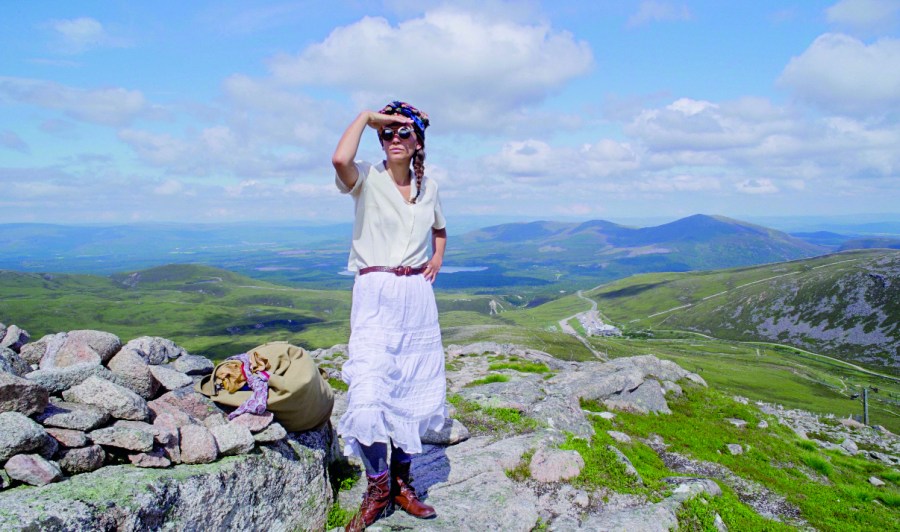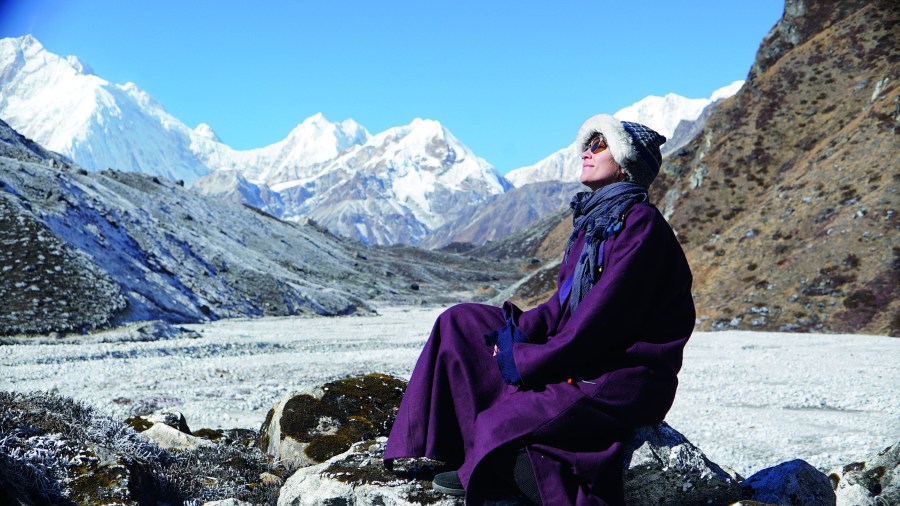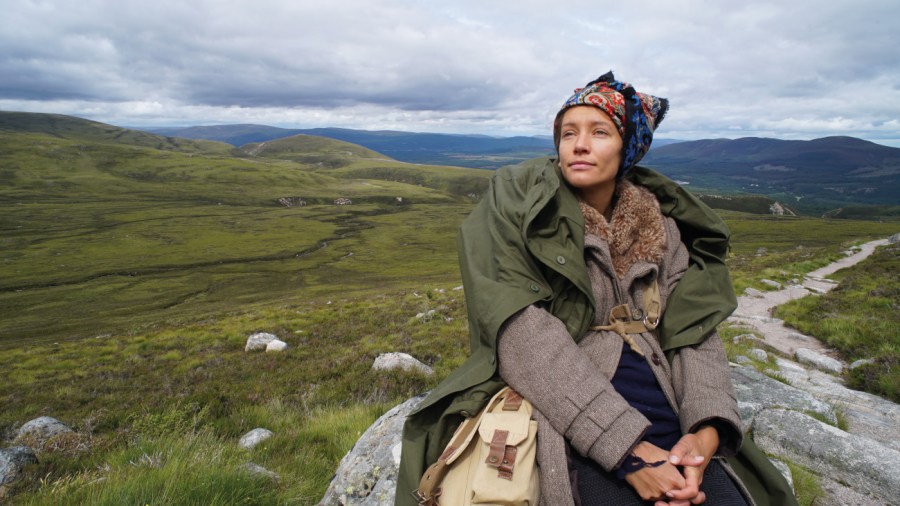Elise Wortley dresses in the outfits of early female explorers to follow in their pioneering footsteps. Here’s how she’s using historical stories to inspire the next generation of adventurers
Elise Wortley has been fascinated by the stories of early female explorers since she was a teenager. In her early twenties, inspired by the journey of 19th-Century adventurer Alexandra David-Néel across the Himalayas to the Tibetan city of Lhasa, she decided to don historical costume and follow in her heroine’s footsteps. It was the start of a project that has seen her undertake history-
inspired adventurers across the globe, always wearing the clothing of the era. Her mission is to understand what female pioneers experienced on their convention-defying journeys and to share their spirit with a modern audience.
Where did the inspiration for your adventures come from?
I read My Journey to Lhasa by Alexandra David-Néel when I was younger. I’d never really heard about any women like her before. The explorers I knew of were all men like Shackleton; I didn’t know women had done these things. She always stayed in the back of my mind, and I thought that one day I might follow in her footsteps.
Finally, when I was in my late twenties, I decided I’d actually do it. And to show how difficult it was for her and for women like her, I decided to retrace her steps in the clothing she’d worn at the time. After that first adventure the project really blew up and I realised that, even though most people haven’t heard of these women, there’s a huge amount of interest in them.
What made you decide it was time to act on that long-held dream?
When I was in my twenties, I got really bad panic attacks. I had to stop going to work at one point, and the only way I ended up feeling better was by going on medication. Whilst it was happening, I didn’t want to go on any planes – I didn’t even want to go on the Tube – so I thought “When I get better, I’ll do that trip”. Those early female explorers were so brave and they faced so many challenges.
I just thought that if they could do that then, I can do it now. So I set off on a journey to India, and since that it’s just grown. As it grows, I grow. It’s quite an amazing thing.
Is it something you’ve managed to make a career out of?
Half and half! I’m an illustrator – I sell my art, and I also worked for a travel company doing their marketing. But I’ve done a couple of partnerships which have paid for the trips and hopefully – eventually – it could become a full-time thing.
How many trips have you done altogether?
Four now. Two in Scotland, one to India and one to Iran.

Elise with Miss Stark Credit: Olivia Martin McGuire
Tell us a bit more about the Scottish trips…
One was following in the footsteps of Nan Shepherd, author of The Living Mountain. I also did another inspired by Jane Inglis Clark, who founded the Scottish Women’s Climbing Club in 1908 because she wasn’t allowed in the men’s one.
It’s now the longest-running women’s climbing club in the world. She did lots of first climbs in Scotland – she was all about getting women into mountaineering. Lots of Scottish women who are into the outdoors know about her, but nobody else seems to, even though she did lots of first climbs in Scotland and was up there technically with the men of that time.
Which trip stands out for you the most?
The Iran one we did this year [travelling to Iran’s Valley of the Assassins, as explorer Freya Stark did in the 1930s]. It was completely crazy! I’ve worked in travel for a long time, so I know Iran is quite a safe place, but we had lots of microphones because we were making a documentary and I have to say I was freaking out a bit on the plane as we were landing! But it couldn’t have been more friendly.
The scenery is so contrasting. You arrive in Tehran and it’s completely polluted, really hot and really arid; but we drove four hours to the foothills of the Alborz mountains and it just completely changed. It’s almost like Switzerland, with these lush, green, rolling hills, and it’s completely untouched. We stayed with families along the way and Iranians are known for their incredible hospitality.
I never would have gone there if it wasn’t for the project, but now I think that anyone who’s into walking should visit.
How much more difficult were the trips because you travelled in period clothing?
When I did the first trip I thought it would be horrendous, but it’s not quite as bad as you might think. In terms of the walking it’s obviously more difficult because you’re slipping a lot. The wool is itchy, the backpack rubs – I had a wooden backpack for that first trip! – but the biggest problem is just the boots.
I always study pictures and do a lot of research into what women wore at the time. In Jane Inglis Clark’s period they all had heeled boots. So I ended up going up Ben Nevis in these heels!
Some of this stuff must be tricky to find…
Yes. There are a lot of people who are still really into the [Second World] War, so Nan Shepherd’s gear from 1945 was quite easy to find. When you go earlier than that, though, it’s difficult. These women were fighting to be taken seriously as writers, so they never wrote in their books what undergarments they were wearing!
I’ve been doing a lot of research into things like when was the first tampon made and what were bras made of.

Elise Wortley in Cairngormes National Park credit Emily Almond Barr
The early female explorers would have faced other difficulties on top of unsuitable clothing. Do you feel that’s still the case?
I think things have changed a lot for white, Western women. In the 1900s women just stayed at home and had children, so for somebody like Alexandra David-Néel to say she wasn’t going to do that was really ahead of her time.
For many women around the world, though, things haven’t changed that much. In Iran, the women are super highly-educated but they don’t have equal opportunities in many ways. Our guide, Nadia, was saying that she’d love to come to the UK and walk in Scotland, but she’s not allowed to even travel here.
What kind of reaction do you get from the people you meet?
It’s different in different countries. In India and Iran, they didn’t even realise I was doing anything unusual! And when we walked up Ben Nevis, everyone thought we were just doing the Three Peaks Challenge. When I tell people, though, they are really interested.

India trip to Kangchenjunga Basecamp, 5000m
Did you have company for any of the trips?
For the Nan Shepherd one I was pretty much on my own. That was because of the nature of the book – I pretty much followed it around and found all the places she spoke about. I was on my own for nearly a month for that one, which was quite amazing. I became really in tune with the landscape around me.
Having said that, part of the project is trying to find female outdoors and adventure guides in the places we visit. In many of the countries, outdoor adventure guides are mostly guys. It’s just a cultural thing.
In India we found pretty much the only female mountain guide there was! As well as the guide I’ve also had someone to film each trip and then the director of our film, so it’s been a little group of women, which is really amazing.
Tell us more about the documentary…
It’s going to focus on the Iran trip. I did film the others, but I never realised how much making a film costs so we didn’t do anything with the rest of the footage. The Iran documentary is sponsored by The North Face and it should be out at the end of the year. We’re going to enter it in all the outdoor adventure festivals.
What other adventures are you planning?
I’m building a huge list of these amazing women from all over the world. The white European explorers were documented a lot more than Asian or African women, so we’re trying to do a lot of research into non-Europeans.
There is one trip that’s my absolute dream, following in the footsteps of the Irish pirate queen Grace O’Malley. She sailed from Clare Island [County Mayo] to Greenwich for a meeting with Queen Elizabeth in a gully boat. It would be crazy expensive with all the safety stuff and I’d have to get a gully boat made because there aren’t many around, but I really hope to do that some day.








